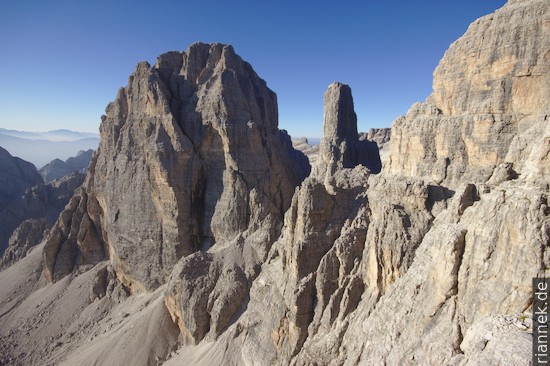
The Brenta, the continuation of the Dolomites beyond the Adige Valley, is famous for the via ferrata that leads across it: the Sentiero Bocchette. However the summits are consistently bypassed, but it is a beautifully exposed path, from hut to hut over rocky ledges and up and down ladders. It consists of several sections, each of which takes half a day at an average pace.
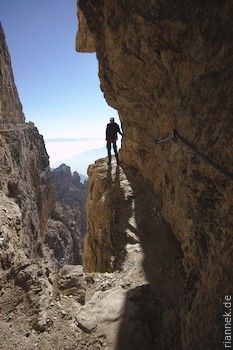
I start at the Grosté Pass, which can be reached by cable car. The cable car station is a 15-minute walk above Madonna di Campilgio. If you get on the bus in Trento at 8 a.m., you can make it to the cable car before the lunch break. I was late, but the first stage was still manageable without any problems.
The first stage is the Sentiero Benini, which is quite short and easy; apart from a few ladders on the descent to the Bocca di Tuckett you hardly ever have to hold on. But it is a nice introduction to what follows. From the Bocca di Tuckett to the Tuckettt hut is a descent of 400 metres in altitude over a glacier remnant, which you have to climb again the next day.
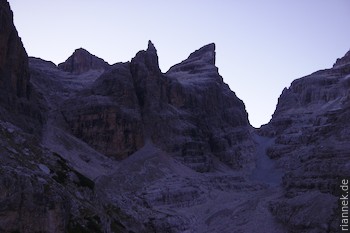
The next stage is the Sentiero Bocchette Alte, the most demanding part, which goes up and down along the Cima Brenta. But even this one is not really difficult and as I am already at the exit shortly after midday, I don’t descend to the Alimonta hut as planned, but continue straight away.

Sentiero Bocchette Centrale is the most famous section. Most of the time it is easy, but beautifully exposed over rocky ledges, and the scenery is so magnificent that it just blows your mind. There are wild towers and pinnacles everywhere, and then you pass the huge rock needle Guglia (Campanile Basso). Unfortunately, the Pedrotti hut was totally overbooked (no wonder, Saturday and then the first perfectly nice weather), but I find a nice place to bivouac… And the next morning I am even motivated to go up the Bocchette Centrale again to see the Guglia with the sun behind me.
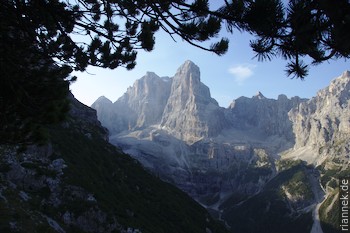
From the Pedrotti Hut, two short trails, Sentiero Brentari and Sentiero dell’Ideale, lead to the 12 Apostoli Hut. The first one is a path upwards that winds through scree, so the climb is more of a downward scramble. The lowest part is a bit tricky, as the glacier has melted so much in the meantime that you have to descend over a rock slab and an improvised aluminium ladder. The ascent on the glacier to the entrance of the Sentiero dell’Ideale is usually only possible with crampons, but in my case the surface was so soft that it was possible without. The following via ferrata is scenically pretty, but I didn’t find it that great from a climbing point of view. Instead of the dell’Ideale, you could also descend to the Agostini Hut and from there via the Via ferrata Ettore Castiglioni (which probably consists mainly of ladders) to the 12 Apostoli Hut.
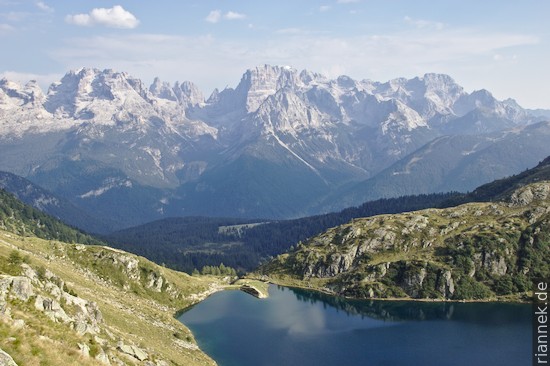
That was it. Instead of going straight down into the valley, I hike to the really beautifully situated Brentei Hut and from there down to Madonna di Campiglio. There I climb up the opposite side of the valley to Lago Ritort, from where I have a great view of the rock towers of the Brenta. The rocks on this side are not carbonates, but granite or, more precisely, tonalite (which, by the way, takes its name from the Tonale Pass, not far away). Here you are already in the Adamello intrusion, which, apart from Bregaglia, is the only large granite intrusion formed during Alpine orogeny. One of the major fault zones of the Alps (Judicarian line) runs through the valley.
Read on
The Formation of Mountains
Dolomites High Route n. 9
Dinosaur tracks near Rovereto